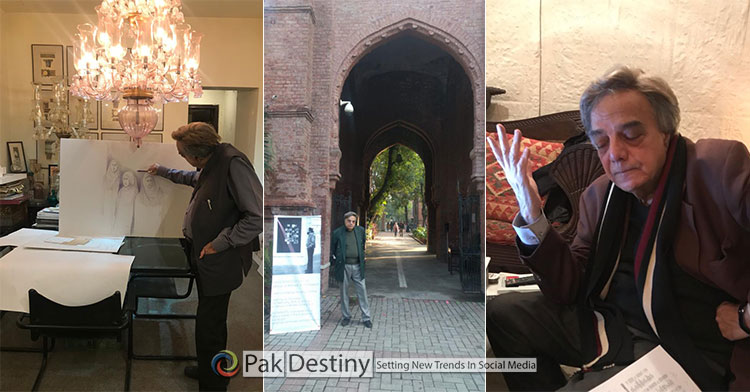
By Sarvat Hossein
It was a memorable rendezvous I had with Nayyar Ali Dada, an acclaimed architect of Pakistan few years ago, on the set of a programme I was hosting with one of the local TV channels in Lahore, Pakistan. The encounter with Dada inevitably was a peerless experience.
Nayyar Ali Dada is a versatile a true artist. An exquisite mind, a distinguished and gifted architect, an activist, fabulous sketcher, environmentalist, an intellectual, painter at heart and a superb and benevolent person besides all that.
The star was born by the surname of Zaidi but in the recognition of his outstanding skills of drawings and paintings, his teacher allocated him the name of “DADA”.
“Freedom is better than being dogmatic”, Nayyar Ali Dada quoted. A man of perfection believes: “we have not caught the threads so far, I do not think we have been able to evolve an identity but we are struggling to find one”.
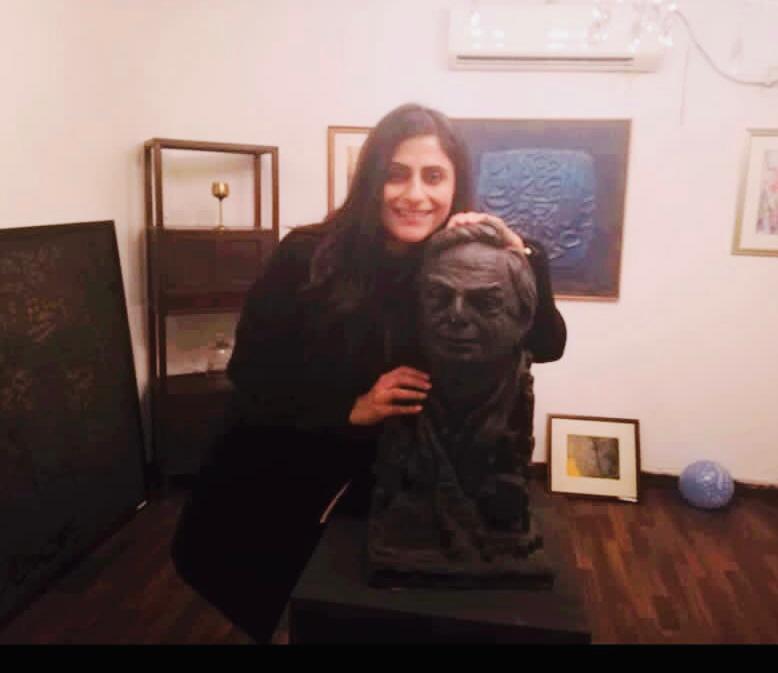
Dada is noted for initiating modern architecture into Pakistani culture. He is assuredly the pioneer in revolutionizing the field of architecture. The Al-Hamra Arts Complex Lahore is certainly an example of his type of modern architecture.
In this building, handmade red bricks were used to echo the two most historically crucial buildings in Lahore, the Lahore Fort and the Badshahi Mosque. The concept of modernism gained its popularity after the second world war, and architectural modernism was adopted by many influential architects and architectural educators. It persists as a dominant architectural style for institutional and corporative buildings into the 21st century.
Dada’s architecture expedition is a pilgrimage which begun in 1976, when his teacher, a glorious painter called Shakir Ali and the eminent poet Faiz Ahmed Faiz recommended Dada for his drawings to the Lahore Arts Council. He confessed in one of his interviews that he was quite baffled and had contemplated long and hard over what he supposed to do as a young boy.
He started to wander around on the roads of Lahore to explore some ideas for his assigned project. He studied many master pieces while touring on the roads of Lahore built by the British architect and he noticed that they were built with the local red bricks. Dada grabbed this idea and decided to use bricks for his project. But he had an awakening from his western training which reminded him that replicating an architectural construction had no true merit.
The Al-Hamra Arts Council Lahore turned out to be a striking building and caught global attention and received immense recognition in the world of architecture. In 1993, this truly luminary artist, showcased his drawing talent again with the sketching of a marvellous piece of art, an open-Air theatre in Lahore. A drum-shaped structure was beautified with blue tiles, traditionally associated with mausoleums.
Nayyar Ali Dada has always been a modernist at heart. Studying his style of work indicates that his work has evolved from modernism to that of a regional modernist with a strong sense of context and an endeavour to exploit the true identity of Pakistani architecture through his designs.
“No (aesthetic) revolution comes suddenly, where people (immediately) shift to building of glass boxes (for instance), it is crucial to have sense of continuity and identity along the lines of the place of the building. The building should have some semblance of belonging to its place or its locality or have the city’s geographical history represented within its structure. This reflection is a good thing”, Dada emphasised.
Dada is a painter at heart but was pushed towards drawings by the intervention of his uncle, who believed painting did not offer a secure future.
” I regret this switch from painting to drawing, because as an architect, I find the whole process very hampered, interfered with and spoiled. In all honesty, we thank God if 70% of our designs come into being. I would have total freedom to do what I wish to do as a painter”.
Mr L. Kipling ( a former principal of National College of Arts )was assigned by the British to introduce their native architectural designs such as Palladian and classical buildings designs with the objective of displaying the strength of their reign to the world. But Kipling denied the idea by replying that these architectural designs, which were intended to be replicated here, were inappropriate for the region’s environmental dynamics, its construction as well as material availability and therefore called them “FOREIGN IMPLANTS”.
The aggrieved Viceroy replied with the rejoinder :”should we build (more of) these indecent, indigenous things?”. Mr Kipling highlighted the issue by saying: “We (the British) were to sit down with the locals and evolve something (a hybrid design) which would both belong here as well as succeed in translating our ideas”.
“Mr Kipling had a meeting with Sir Ganga Ram (a brilliant engineer) and Bhi Ram Singh (a craftsman, artist and sculptor) and evolved the hybrid architecture referenced earlier which was purely based on the ideas and layouts of the British and was hinged practically on our native material (bricks, language and arches)”, Dada shed further light on the issue.
This design orientation led to the construction of impressive buildings of Lahore such as the High Court, Aitchison College and the Punjab University buildings, providing an excellent lesson on how to create hybrid architecture which caters for both the past as well as the present, and takes care of the identity as well as utilising the creative local talent.
To the world, Dada is known as an architect of distinction, but he is also a great lover of classical music, especially bhajans. One of his favourites is “TERE MANDIR KA HOON DEEPAK JAL RAHA BY PANKAJ MULLICK” which he often croons. And he is a man who also has an astute eye for porcelain and he is a notable raconteur.
Nayyar Ali Dada’s spartan yet conscientious taste is reflected in the Nairang Art Gallery, Lahore, which is much appreciated by the literary and other intellectuals of the city. Dada organised the “BAITHAK” every month in the Nairang Art Gallery Lahore to provide a fabulous opportunity for artists, poets and intellectuals to assemble and shared their work and experiences.
The small cafe inside the gallery offers true contentment and has some lovely antique artefacts that come from Dada’s personal collection. It offers people a relaxed and cosy environment to enjoy.
But that is not all; There is music in the air, not the piped music people hear in dimly-lit restaurants, but some real chaste music, like Bare Ghulam Ali Khan’s kamod. The upper two rooms of Nairang Galleries are dedicated to the works of new painters. An elevated platform bestows access to a small library which holds books on music, painting, literature and criticism. Dada thoroughly enjoys the sight of people browsing through the books and to him, it does not matter if they don’t purchase any items. There are a few chairs which have been strategically placed around the venue for the comfort of serious browsers.
A section of the gallery displays prints of paintings of renowned painters such as, Picasso, Matisse, Chughtai and Sadequain, et al. They are modestly priced for the general public. Dada calls it affordable art; he is all for replicating old art, old furniture, old artifacts and old designs. The past, Dada feels, must be carried forward and used, rather than worshipped.
A few years ago, the Indian Punjab Governor VP Singh Badnore, released a book edited by Aabha Narain Lambah. Nayyar Ali Dada authored a chapter on Lahore. The book maps the cultural landscape of the undivided Punjab with its Sufi shrines, forts and palaces and comes up with some interesting nuggets. The enigmatic Dada had spoken at the event: “The Persian invaders blended very well with the local culture and the fusion created a very superior culture in the Punjab. Architecture is like whisky and good blending brings out its character”.
Nayyar Ali Dada is very sensitive to his surroundings and that is what fuels his art. As Salvador Dali said, ‘a true artist is not one who is inspired, but one who inspires others’.
Dada’s genius is in his designs and he has inspired many artists. His designs speak of perfections like Michelangelo (Italian, sculptor, painter, architect and poet of the renaissance) articulated that: “The true work of art is but a shadow of the divine perfection”.
Dada was selected as one of 50 most influential names in Architecture and Design for 2015 by the Architectural Digest of India. Ijaz Malik’s sculpture pieces were displayed at the Nairang Art Gallery, Lahore. He paid a marvellous tribute to Nayyar Ali Dada by capturing Dada’s characteristic smile and his enormous contribution to the world of architecture, indicating through the block-like structure around him.
Dada admires Sri Lankan architect Geoffrey Bawa’s work. Bawa was one of the original proponents of Tropical Modernism, a design movement in which sensitivity for the local context combines with the form-making principles of modernism.
The Pride of Performance Award was given to Dada by the Government of Pakistan in 1992, and The Agha Khan Award for Architecture for Al-Hamra, Sitara-i-Imtiaz in 2003; the Hilal-i-Imtiaz (Crescent of Excellence) Award was presented to him by the President of Pakistan in 2018.
Undoubtedly, these are well deserved awards for Nayyar Ali Dada’s outstanding designs. His colleagues confessed that he is a remarkably hard-working person and truly earned his place in the world of architecture.
Many Iconic buildings in Lahore are designed by Dada, such as the Shakir Ali Museum, the Grand Jamia Mosque, the Al-Hamra Arts council building, the Gaddafi Stadium, Bagh-e-Jinnah (where he restored the historic garden), the Shoukat Khanum Hospital and the Quaid-e-Azam library etc.
There should be a public demand to name any important road after Nayyar Ali Dada. A true superstar of the world of Architect of his time, and still going on strong! — PAK DESTINY
Sarvat Hossein
British- Pakistani Free lance Journalist



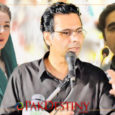
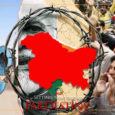
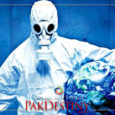


marzi h boss